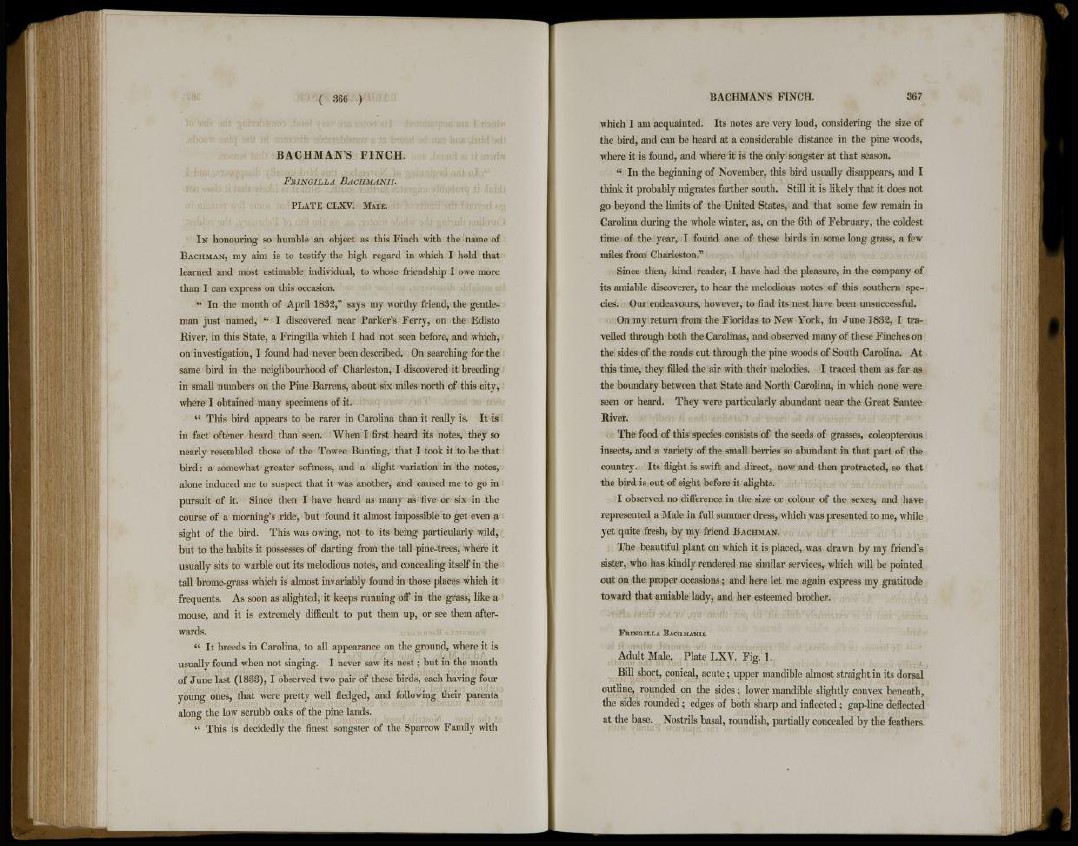
B A C H M A N ' S F I N C H .
FRINGILLA BACHMANII.
P L A T E C L X V . MALE.
I N honouring so humble an object as this Finch with the name of
BACHMAN, my aim is to testify the high regard in which I hold that
learned and most estimable individual, to whose friendship I owe more
than I can express on this occasion.
" In the month of April 1832," says my worthy friend, the gentleman
just named, " I discovered near Parker's Ferry, on the Edisto
River, in this State, a Fringilla which I had not seen before, and which,
on investigation, I found had never been described. On searching for the
same bird in the neighbourhood of Charleston, I discovered it breeding
in small numbers on the Pine Barrens, about six miles north of this city,
where I obtained many specimens of it.
" This bird appears to be rarer in Carolina than it really is. It is
in fact oftener heard than seen. When I first heard its notes, they so
nearly resembled those of the Towee Bunting, that I took it to be that
bird: a somewhat greater softness, and a slight variation in the notes,
alone induced me to suspect that it was another, and caused me to go in
pursuit of it. Since then I have heard as many as five or six in the
course of a morning's ride, but found it almost impossible to get even a
sight of the bird. This was owing, not to its being particularly wild,
but to the habits it possesses of darting from the tall pine-trees, where it
usually sits to warble out its melodious notes, and concealing itself in the
tall brome-grass which is almost invariably found in those places which it
frequents. As soon as alighted, it keeps running off in the grass, like a
mouse, and it is extremely difficult to put them up, or see them afterwards.
" It breeds in Carolina, to all appearance on the ground, where it is
usually found when not singing. I never saw its nest; but in the month
of June last (1833), I observed two pair of these birds, each having four
young ones, that were pretty well fledged, and following their parents
along the low scrubb oaks of the pine lands.
" This is decidedly the finest songster of the Sparrow Family with
which I am acquainted. Its notes are very loud, considering the size of
the bird, and can be heard at a considerable distance in the pine woods,
where it is found, and where it is the only songster at that season.
" In the beginning of November, this bird usually disappears, and I
think it probably migrates farther south. Still it is likely that it does not
go beyond the limits of the United States, and that some few remain in
Carolina during the whole winter, as, on the 6th of February, the coldest
time of the year, I found one of these birds in some long grass, a few
miles from Charleston."
Since then, kind reader, I have had the pleasure, in the company of
its amiable discoverer, to hear the melodious notes of this southern species.
Our endeavours, however, to find its nest have been unsuccessful.
On my return from the Floridas to New York, in June 1832, I travelled
through both the Carolinas, and observed many of these Finches on
the sides of the roads cut through the pine woods of Sovith Carolina. At
this time, they filled the air with their melodies. I traced them as far as
the boundary between that State and North Carolina, in which none were
seen or heard. They were particularly abundant near the Great Santee
River.
The food of this species consists of the seeds of grasses, coleopterous
insects, and a variety of the small berries so abundant in that part of the
country. Its flight is swift and direct, now and then protracted, so that
the bird is out of sight before it alights.
I observed no difference in the size or colour of the sexes, and have
represented a Male in full summer dress, which was presented to me, while
yet quite fresh, by my friend BACHMAN.
The beautiful plant on which it is placed, was drawn by my friend's
sister, who has kindly rendered me similar services, which will be pointed
out on the proper occasions; and here let me again express my gratitude
toward that amiable lady, and her esteemed brother.
FRINGILLA BACHMANII.
Adult Male. Plate LXV. Fig. 1.
Bill short, conical, acute ; upper mandible almost straight in its dorsal
outline, rounded on the sides; lower mandible slightly convex beneath,
the sides rounded; edges of both sharp and inflected ; gap-line deflected
at the base. Nostrils basal, roundish, partially concealed by the feathers.